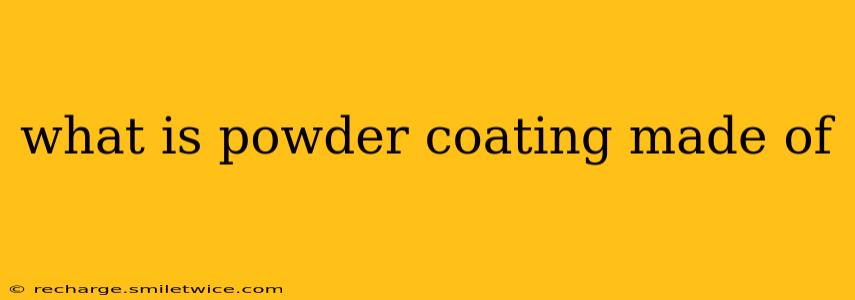What is Powder Coating Made Of? A Deep Dive into Composition and Properties
Powder coating is a type of finish applied as a free-flowing, dry powder. Unlike conventional liquid paints, it doesn't require solvents to keep the binder and pigment suspended. But what exactly is this dry powder? Let's break down its composition and explore why it's such a popular choice for a durable and attractive finish.
The primary components of powder coating are:
-
Resin: This is the binding agent that holds everything together. Common resin types include polyester, epoxy, polyurethane, and hybrid blends (combining the properties of different resins). The choice of resin significantly influences the powder coating's final properties like flexibility, durability, and chemical resistance. Polyester resins, for instance, are known for their excellent UV resistance, making them ideal for outdoor applications. Epoxy resins offer superior chemical resistance.
-
Pigments: These provide the color and aesthetic appeal of the powder coating. A wide array of pigments is available, allowing for virtually any color imaginable. Pigments also affect other properties, such as gloss level and hiding power (ability to cover the substrate completely).
-
Additives: These are included to enhance specific properties of the final coating. Common additives include:
- Flowing agents: Improve the flow and leveling of the powder during application, leading to a smoother finish.
- Curing agents: Initiate the chemical reaction (crosslinking) that converts the powder into a solid film during the curing process.
- Catalysts: Speed up the curing process.
- UV stabilizers: Protect the coating from degradation caused by ultraviolet radiation, especially important for outdoor applications.
- Leveling agents: Further enhance the smoothness of the final finish.
- Antioxidants: Protect the coating from oxidation and degradation.
What are the Different Types of Powder Coatings?
The diversity of powder coatings arises from the various combinations of resins, pigments, and additives. Here are some common types:
-
Polyester Powder Coatings: Known for their excellent UV resistance, weatherability, and color retention. They are widely used for outdoor applications like automotive parts, furniture, and appliances.
-
Epoxy Powder Coatings: Offer superior chemical resistance and hardness, making them suitable for applications requiring protection against chemicals and corrosion. They are often used in industrial settings.
-
Polyurethane Powder Coatings: Provide excellent flexibility, impact resistance, and scratch resistance. They are frequently used in applications where durability and flexibility are crucial.
-
Hybrid Powder Coatings: Combine the properties of different resins (e.g., polyester and epoxy) to achieve a balance of desirable characteristics, such as excellent UV resistance and good chemical resistance.
How is Powder Coating Applied?
Powder coating is applied electrostatically. The powder is charged and sprayed onto the grounded workpiece, where it adheres due to electrostatic attraction. The coated workpiece is then cured in an oven at high temperatures, typically between 350-450°F (175-230°C), causing the powder to melt, flow, and chemically crosslink to form a tough, durable coating.
What are the Advantages of Powder Coating?
Powder coating's popularity stems from its numerous advantages, including:
- Durability: Powder coatings are exceptionally tough and resistant to chipping, scratching, and abrasion.
- Chemical Resistance: Many powder coatings offer excellent resistance to chemicals, solvents, and corrosion.
- UV Resistance: Especially polyester-based coatings, offering long-lasting color and protection from sunlight.
- Environmental Friendliness: Powder coating is a low-VOC (volatile organic compound) process, making it a more environmentally friendly alternative to liquid painting.
- Wide Range of Colors and Finishes: Allows for extensive customization and design flexibility.
What are the Disadvantages of Powder Coating?
While numerous advantages exist, it's also crucial to acknowledge the limitations:
- Repair Difficulty: Repairing damaged areas can be challenging and may require recoating the entire piece.
- Initial Cost: Powder coating can be more expensive than some liquid paint alternatives upfront, although its long-term durability can offset this cost.
- High Temperature Curing: The high-temperature curing process can limit the types of substrates that can be powder-coated.
Understanding the composition and properties of powder coating provides valuable insight into its widespread use across various industries. From appliances to automotive parts, its durability, aesthetic versatility, and eco-friendliness make it a top choice for many applications.
